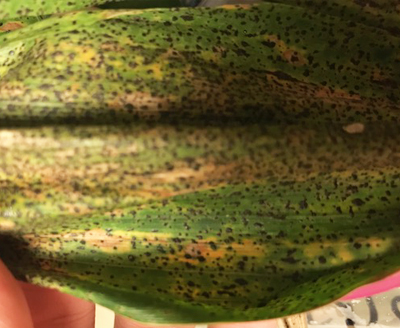
- Tar spot was reported for the first time in the US in 2015 in IN then in IL and it has now been confirmed in Iowa, Wisconsin, Michigan and Florida.
- Symptoms begin as oval to irregular bleached to brown lesions on leaves in which black spores are formed. Lesions may also be present on leaf sheaths and husks.
- Not much is known about this disease and in areas where yield losses are significant; the “tar spot complex” needs to be present.
- Since it was first reported in the Midwest, no in-season management has been needed for this disease.
- However, in 2018, tar spot symptoms have been heavier and easier to “spot” raising concerns about potential yield impacts and standability.
- Researchers in the Midwest are currently working on getting more information on tar spot epidemiology, yield impacts and management implications.
Biology and Disease Cycle
Tar spot is caused by the fungus Phyllachora maydis. Not known to be seedborne, this pathogenic fungus could be transported on fresh/ dry corn leaves or husks. Ascospores of P. maydis would then be moved by wind or rain splash to corn. The disease is favored by cool temperatures, high relative humidity and long periods of leaf wetness. Windborne spores are released in periods of high humidity. Disease development generally starts at flowering time but infection can occur as early as V8 to V10. P. maydis does not survive well in the absence of a host plant and it is not known whether the fungus can survive a Midwest winter.
To cause economic damage the "tar spot complex" needs to be present. The tar spot complex consists of two pathogenic fungi; P. maydis and Monographella maydis. Fortunately since it was first identified in IN and IL in 2015, P. maydis is the only fungus reported in the U.S.

Symptoms
Tar spot symptoms include small, raised, black spots scattered across the leaf surface (Pic. 1) although spots can also be present on leaf sheaths and husks. These black spots are the fruiting structures (ascomata) of P. maydis. They protrude from the leaf surface giving it a rough or bumpy feel. They can be small flecks of about 1/64" up to about 5/64". The lesions can merge together producing larger areas of blighted leaf tissue.
Symptoms of tar spot can be confused with common and southern rust. Late in the growing season rust fungi switch from producing orange-red pustules to black teliospores. These black pustules can be easily mistaken for tar spot lesions. One way to distinguish them is by scraping away the pustules with your fingertips. Tar spot lesions will not be scraped off the leaf tissue while rust spores will rub off.
Management
Because tar spot symptoms have been detected late in grain filland at low severity levels, no in-season management has been needed or recommendedfor this disease. Furthermore with it being a relatively new pathogen in the US, no information on hybrids, fungicides and cultural tools is available yet. However, the severity of tar spot symptoms observed in some areas in 2018 hasraised concerns about the yield damaging potential of this pathogen. Unfortunately until more research is done and more information becomesavailable we do not know which tools, if any, can be effective. Researchers areworking on understanding the disease triangle for this pathogen and we hope toeventually have more information on potential hybrid resistance, fungicides orcultural tools.
Suggested reading:
- Chalkley, D..Systematic Mycology and Microbiology Laboratory, ARS, USDA. . Invasive Fungi. Tar spot of corn-Phyllachora maydis)
- https://www.extension.purdue.edu/extmedia/BP/BP-90-W.pdf
Picture 1. Tar spot lesions on leaf surface. (Source: GROWMARK, Inc.).
Picture 2. Tar spot lesions on husk (Source: GROWMARK, Inc.).